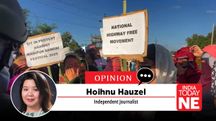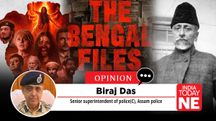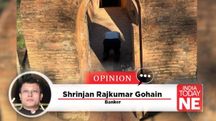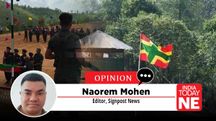When an IGP Barged into the Sana Konung Gates, the Ghosts of 1949 and 1971 Returned in Manipur
The incident of 20 November 2025 between Inspector General of Police Themthing Ngashangva and Rajya Sabha MP and titular Maharaja Leishemba Sanajaoba has understandably stirred emotions in Manipur. Yet, before the episode is magnified beyond proportion, a word of calm and perspective is needed.
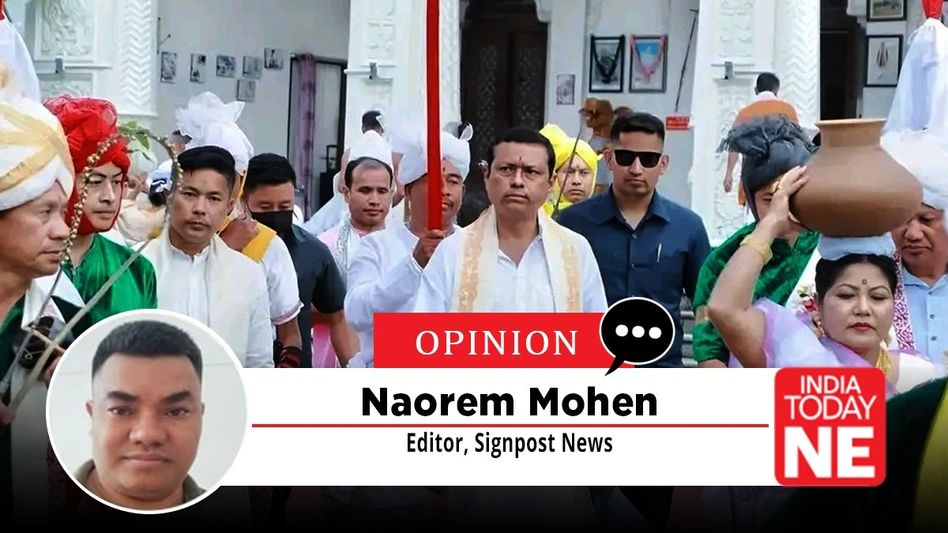
The incident of 20 November 2025 between Inspector General of Police Themthing Ngashangva and Rajya Sabha MP and titular Maharaja Leishemba Sanajaoba has understandably stirred emotions in Manipur. Yet, before the episode is magnified beyond proportion, a word of calm and perspective is needed.
The Tangkhul community to which IGP Themthing belongs has, for generations, shown deep respect and loyalty towards the institution of the Maharaja and the Ningthouja dynasty. Many Tangkhul villages still send ceremonial gifts to Sana Konung during Lai Haraoba, Cheiraoba and Mera Hou Chongba, and the Maharaja enjoys warm patronage across the hills.
What happened that afternoon appears, from all available accounts, to have been a genuine misunderstanding during a tense law-and-order situation involving protests and Internally Displaced Peoples (IDP).
The office of Rajya Sabha MP and titular Maharaja Leishemba Sanajaoba has alleged that IGP (Zone-I) Themthing Ngashangva forcibly entered the Sana Konung palace compound on 20 November 2025 and threatened his security personnel with FIRs for allegedly sheltering protesters.
In response to allegations, Manipur Police issued a clarification on X. The incident arose from a protest by 50-60 COCOMI volunteers defying prohibitory orders, who marched from Govindajee Crossing toward Hapta Kangjeibung with placards and slogans against the Sangai Festival 2025.
Around 1:15 p.m., security teams, supervised by Ngashangva, repeatedly urged peaceful dispersal, but the mob turned violent—hurling water bottles, placards, and racially abusing the IGP, with a woman protester assaulting him. As the group moved to the palace, where MP's guards allegedly allowed entry and hindered police, Ngashangva approached the gate to question them but did not enter the premises.
Both men are seasoned public servants who have served Manipur with distinction. A quiet word, a handshake, and a joint appeal for peace from the Maharaja and the IGP would instantly calm hearts and set the most healing example for a state that needs unity more than ever.
Let this small cloud pass quickly, so that the larger sky of brotherhood in Manipur remains If the IGP's actions (threats or entry) were seen as intimidation interfering with the MP's parliamentary duties—especially with the Winter Session imminent—this could qualify as a breach. The MP could file a privilege motion in Rajya Sabha, arguing it undermined his freedom from "undue interference."
The incident of 20 November 2025 clearly fell within the protected pre-session period (protective window of 40 days before the session commences and 40 days after it ends). If the MP Leishemba Sanajaoba chooses to move a privilege motion, the Rajya Sabha Committee of Privileges will have strong grounds to examine whether the IGP’s conduct amounted to an attempt to obstruct a Member of Parliament.
This is not ancient history. This is the living wound that reopened when an armed police officer treated the Maharaja of Manipur like any common citizen. Any perceived overreach can always be examined through proper parliamentary channels if required. But the larger story of Manipur and India does not need another controversy; it needs reconciliation and mutual respect.
Manipur was never a princely state under direct British rule in the same way as Travancore or Gwalior. It was an independent kingdom that signed a Standstill Agreement with India in August 1947 and then, in May 1947, adopted its own progressive constitution—the Manipur State Constitution Act, 1947—under which a fully elected assembly functioned. Maharaja Bodhachandra Singh ruled as a constitutional monarch.
Yet on 21 September 1949, under circumstances that have been described for decades as coercive (the Maharaja was kept virtually in confinement at Shillong), he signed the Merger Agreement. In return for ceding all authority over defence, external affairs, and communications, the Government of India gave solemn, written guarantees:
Article II couldn't be clearer: "His Highness the Maharajah shall continue to enjoy the same personal rights, privileges, dignities, titles, authority over religious observances, customs, usages, rites and ceremonies and his private purse allowance which he would have enjoyed had this agreement not been made."
Article III extended this to heirs like Sanajaoba.
Article IV secured private properties, and family members got their due protections. These weren't optional niceties—they were the bedrock of the deal. The Maharaja surrendered sovereignty for guarantees of dignity, financial security via a tax-free privy purse, and unchallenged authority over cultural and religious matters. As the guardian of Sanamahi traditions and Meitei heritage, the king was to remain untouchable, his palace a fortress of respect.
These were not ornamental clauses. They were the price India paid for Manipur’s sovereignty. The Maharaja did not beg to join India; India persuaded—and many say forced—him, and paid in the currency of perpetual dignity and financial security.
However, 22 years of the signing of Merger Agreement, through the 26th Constitutional Amendment, Indira Gandhi’s government abolished Articles 291 and 362 of the Constitution in 1971, derecognising all former rulers, and stopped the privy purses with immediate effect. The annual amount for the Manipur royal family was a modest ₹1.70 lakh—hardly a burden on the national exchequer.
Yet the symbolic and material blow was devastating.The Supreme Court, in Madhav Rao Scindia v. Union of India, initially struck down the presidential order derecognising the rulers, but Parliament quickly passed the constitutional amendment to override the court. The rulers lost not only their purses but their titles, their constitutional recognition, and, most painfully, the promise that their dignity would remain untouched.
If the consideration offered by India in 1949—perpetual titles, privileges, and financial support—was unilaterally withdrawn in 1971, then the fundamental principle of contract (and international treaty law) comes into play: failure of consideration renders the entire transaction voidable. Manipur gave up its independence on the strength of India’s word. India broke its word.
Manipur today is an inseparable and cherished part of India. Its unique history, culture, and the institution of the Maharaja continue to command affection and respect across the state and the country. The palace of Sana Konung remains a living symbol of that heritage, and the titular Maharaja continues to play a constructive role as a Rajya Sabha MP, as a patron of indigenous faith and culture, and as a voice of harmony.
Rather than reopening old chapters in a spirit of grievance, the wiser and more fruitful path, one that Manipuris themselves have always preferred, is to build new chapters of understanding:Let the Government of India and the State Government jointly institute annual grants for the preservation of Meitei indigenous religion, manuscripts, and traditional arts under the patronage of the titular Maharaja, recognising his continuing cultural role.
Let protocols of courtesy be formalised so that the palace and the Maharaja are always approached with the dignity that Manipur’s history deserves.
Let educational curricula in schools and universities highlight both the circumstances of 1949 and the larger journey of integration, so that young Manipuris grow up with pride in their past and confidence in their future within India.
These steps require no constitutional amendment, no confrontation, only goodwill, and they would heal far more than any debate about legal technicalities ever
The incident of 20 November 2025 need not become a wound; it can become a reminder of how much Manipur has overcome and how much more it can achieve when hearts remain large and hands remain joined.
Maharaja Leishemba Sanajaoba and IGP Themthing Ngashangva both love Manipur deeply. If they sit together under the same roof of Sana Konung, share a cup of tea, and issue a joint message of peace and mutual respect, the entire state will breathe easier and smile wider.That single gesture would be worth more than a hundred seminars or a thousand articles.
It would show the rest of India, and the world, the true spirit of Manipur: resilient, generous, and always ready to turn a moment of tension into a lifetime of togetherness.The gates of Sana Konung have stood for centuries.
They have welcomed friends in times of joy and sheltered the people in times of trouble. May they always open to understanding, never close in anger.Manipur’s best days are still ahead, within India, with pride in its past and faith in its future.
Suspending the IGP or issuing apologies will not heal this injury. What Manipur needs now is an honest national conversation:
Article 371C safeguards hill areas of Manipur, but royalty? Ignored. Yet, merger promises were once constitutional— their erasure doesn't absolve cultural duties. The 1947 Manipur Act still crowns the king as regent; let us honor that!
Was the 1949 Merger Agreement obtained under duress? Did the unilateral abolition of privy purses and privileges in 1971 constitute a material breach that voids the Agreement?
If the answer to either question is yes, what does India owe the people of Manipur—and their titular Maharaja—today?
Until these questions are faced squarely, every forced entry into Sana Konung, every insult to the Maharaja’s person, will only remind Manipuris of a promise made in 1949 and broken in 1971.The gates of the royal palace may be repaired, but the breach in trust will not be mended so easily.
Copyright©2025 Living Media India Limited. For reprint rights: Syndications Today
